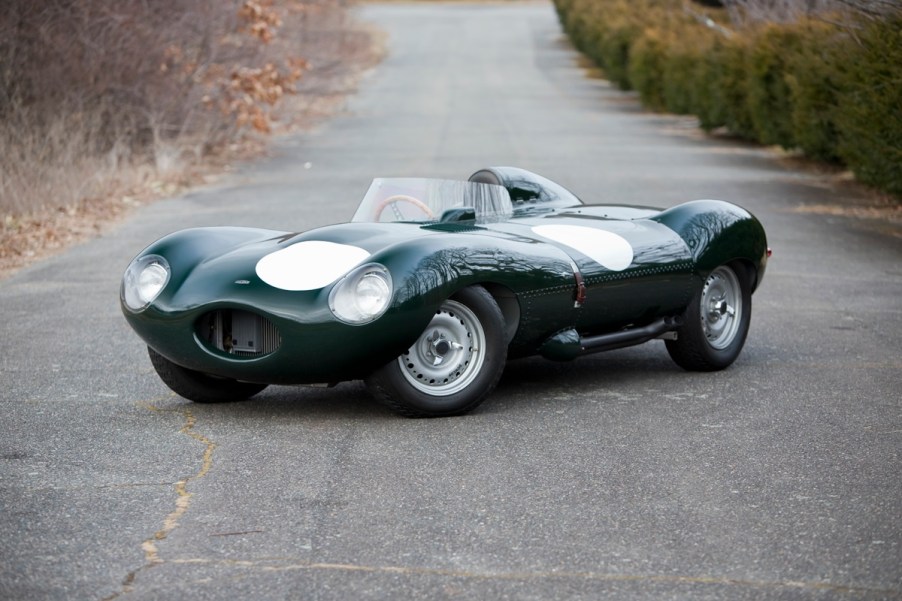
How Much Would You Pay for a Fake Jaguar?
Restomodding a classic vehicle like a Ford Bronco, Range Rover or Porsche 911 is all well and good. It helps keep the classics alive, letting people enjoy them through modern quality controls and technology. But that still depends on you having a vehicle to restore in the first place. And when it comes to iconic cars, like the Le Mans-winning Jaguar D-Type, that’s really only possible for the truly well-to-do.
But there is a way to get a Jaguar D-Type that has, if not the racing history, then at least the racing performance. And that’s by getting a replica.
The Tempero Jaguar D-Type replica

As of this writing, Bring a Trailer has listed a Jaguar D-Type replica made by New Zealand’s Tempero Coach & Motor Company. Now called Rod Tempero, the company has built several Jaguar replicas in the past: Road & Track reported an XJ13 replica was sold by RM Sotheby’s in 2019. This is the 26th D-Type replica Tempero made.

The aluminum body was made hand. The panels are riveted to a ‘factory-style’ aluminum monocoque; the D-Type was one of the first cars to have one. Like the original, the driver’s headrest is part of a fairing elongated for aerodynamics. Also, the Jaguar D-Type replica has 4-wheel disc brakes, although the rear ones are inboard to reduce unsprung mass. The car is right-hand drive, with a cover on the passenger’s side to reduce drag. There is no passenger seat, although the driver does get a 4-point racing harness.

Under the hood is a 4.2-liter inline-six with 3 Weber carburetors, linked to a 4-speed manual. Exact power is unknown, although R&T reports the original 3.4-liter version made roughly 250 hp. Which, in 1955, was good for 190 mph.

Tempero isn’t the only one that can make a replica Jaguar D-Type, though. Michigan-based Race Car Replicas can, as well. And, for a very brief time, Jaguar itself could make you a D-Type, too.
Only this was no replica. To support the growing appreciation for classic cars, many automakers started ‘classics’/’heritage’ departments. These departments initially only offered parts or restoration services. But soon, some started making brand-new versions of past icons. And Jaguar was one of them.
Jaguar replicas continuations
The first was the XKSS, which R&T reported had already been re-created by other companies. Originally, Motor Trend explained, Jaguar was supposed to make 25 of the D-Type-based cars, but 9 were destroyed in a 1957 factory fire. But Jaguar used original drawings, as well as 3D scans of surviving cars, to make new parts, and complete the run.
Jaguar repeated this with one of its most famous and beloved cars, the E-Type. Enzo Ferrari called it “the most beautiful car ever made”. It’s such a styling icon, New York’s MoMA has one in its collection. But there were some E-Types that were even more special.
These were the E-Type Lightweights, named for their lightweight aluminum bodies and chassis, and their aluminum-block engine, according to Car and Driver. The Lightweights also received an updated transmission and mechanical fuel injection. MT reports that of the planned 18, only 12 were made—but in 2015, Jaguar announced it would make the remaining 6 to the original specs. The automaker followed up with 12 more ‘regular’ E-Types, Car and Driver reported.

Finally, Jaguar’s classics department turned its eyes on the D-Type. Originally, R&T and Hagerty explain, Jaguar planned on building 100, but only built 75. The remaining 25 were meant to be turned into XKSS models. So, in 2018, Jaguar’s engineers and designers took original documents and photos and produced the D-Type once more.

But all these cars weren’t actually replicas. In the case of the E-Type Lightweights, Jaguar actually reused the VINs that were supposed to go on the original 6 cars. These 3 cars are ‘continuation cars.’ They’re built to the original standards and specs, which means they’re FIA vintage-racing-legal, according to Jalopnik. They’re classics, just…not old.
Price comparison
Compared to these ‘official’ continuation cars, the Tempero Jaguar D-Type can seem like a cheap knock-off. But while it definitely isn’t a knock-off—New Zealand’s Autocar reports Tempero uses the same kind of traditional techniques as Jaguar did—the price is actually part of the appeal.
Original D-Types and E-Types are expensive. R&T reports an E-Type Lightweight sold in January 2017 for the equivalent of $7,000,000. In 2016, the D-Type that won the 1956 24 Hours of Le Mans sold for $21,780,000. The continuation cars are definitely cheaper, but they’re not exactly cheap: the continuation Lightweight was estimated to cost $1,600,000.
In contrast, as of this writing, the D-Type replica on BaT is listed at $1,000. And it’s actually more advanced than the original: it’s got independent rear suspension, for one. At that price, you won’t be afraid to drive and enjoy it, the way it was meant to be used.
This is one ‘fake’ that’s, in some ways, actually better than the original.
Follow more updates from MotorBiscuit on our Facebook page.


